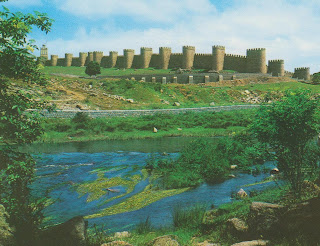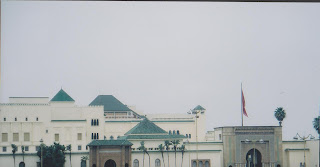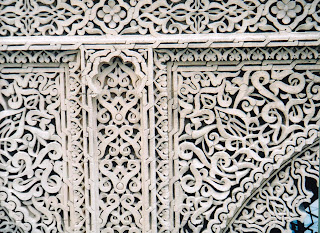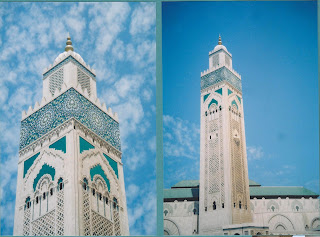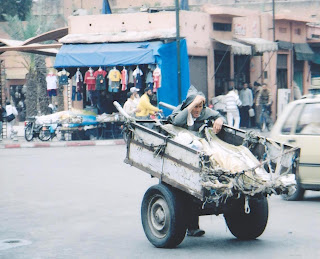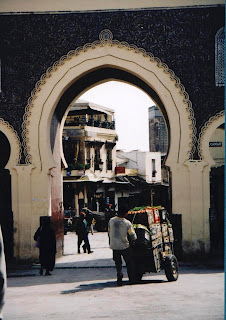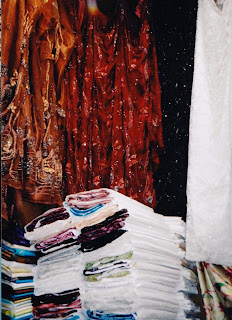Memories of our trip to
MOROCCO:
Morocco has a wealth of deep cultural history and architectural tradition. There are medieval cities, Roman ruins, Berber fortresses and beautiful Islamic monuments to see.
Morocco provides the taste of Islamic culture, Africa, and the developing world. It can be quite a cultural shock, but it offers a unique experience. It is full of contrasting images, exotic sights, strange smells and experiences. It is full of variety and life. Full of colors and fragrances.
Every Moroccan city has a Medina, the old quarter where the past still echos and the flow is never ending. Here are found the craftsmen, the traders, and the hammam (traditional steam bath).
The souk or market, along with the mosque make up the main elements of a Muslim town. "All roads lead to the Souk". A treasury trove worthy of Ali Baba and guarded by massive gates, the souk is a succession of narrow alleyways, with back to back shops that are rarely bigger than a linen cupboard. Tinsmiths, grocers, butchers, bakers, tailors, spice merchants, and cake vendors meet daily in mayhem. In the souk, the merchant, perched atop of his colorful display of spices, calls to the passersby. These are the spices that give their food a tough of color, taste and smell.
Currently, ten Moroccan dirham equals 1.51 Canadian dollars.
Sun. April 25
We reached the coast of Spain south of Seville at Algeciras were we boarded the ferry to go to Morocco.
Rock of Gibraltar
Then we were back on the bus travelling south along what was once Africa's infamous Barbary coast to Rabat, Morocco's capital.
Mon., April 26 to April 27th RABAT, MOROCCO
We are staying at the Majliss Hotel in Rabat.
This morning in Rabat we visited the Royal Palace.
There is an extravagant embellishment with the geometric mosaics which cover everything from the walls, floors, columns and fountains everywhere.
And the Mausoleum to Mohammad V.
Pictures from the Medina in Rabat:
Then we went further south to Casablanca, Morocco's largest and most cosmopolitan city, home of the extraordinary Hassan II Mosque. Eternally immortalized by the classic film "Casablanca", the name of this city has a mysterious exotic ring to it.
The mosque in Casablanca is one of the most beautiful ones I have ever seen with its amazing works of turquoise and blue mosaics, marble and granite. It can hold up to 25,000 worshippers inside and a further 80,000 in the outside courtyard.
 |
| Casablanca |
April 26 to April 28
MARRAKECH, MOROCCO
Driving deeper into the heartland of Morocco by way of Settar, we reached Marrakesh, the most enchanting city. We are staying at the El Andalous Hotel.
Most of the buildings in Marrakech are done in a peach color plaster and everyone here is going somewhere fast.
 |
| Marrakesh |
A tour of the Medina Palace in Marrakesh
Followed by the hustle and bustle of the old Medina in Marrakesh that takes you back to a long forgotten world.
A lot of the alley ways are dark and closed in.
Here you will find the scent of exotic spices piled high for you to buy.
And pastries
Along with piles of babush slippers in all shapes, sizes and colors. These are the common foot wear found here. Men tend to wear yellow or white ones and women wear the bright colors and patterns.
And snake charmers,
 |
| ...and a camel ride if you want... |
We saw the water sellers wearing their colorful hats and ringing their bells. They will sell you a cup of water or pose for your tourist pictures.
We decided to do an excursion from Marrakesh thru the Gorge of Oued Ourika to the Ourika Valley, in the foothills of the Atlas Mountains. We travelled thru the quiet, peaceful green countryside. In the background were the blue-grey mountains of the High Atlas. We went along the river banks and meandered thru the mountain foothills, thru the villages built of baked clay and stone until eventually we stopped at a clay built Berber home.
The average house in the village has a small kitchen and one room with small rugs on the floor, benches, and perhaps a small TV. The whole family eats and sleeps here. Most houses here don't have running water.
We stopped to visit Omar and his family of eight. The livestock lived in the ground level and their family lived in the upper rooms. We were offered a glass of fresh hot mint tea poured from a silver pot into glasses and a couple of pieces of homemade Berber bread and olive oil.
 |
| Omar |
Mint tea, the national Moroccan drink is so important in daily interactions that it is often jokingly referred to as Berber whiskey. It is offered as a gesture of welcome and hospitality.
For supper this evening we were served a delicious traditional dish called "tajine" or "tangine". A tajine is a dish from North Africa that is named after the special earthenware pot in which it is cooked. The dish consists of a flat circular bottom base and a large cone shaped cover that rests inside the base during cooking over an open fire or a gas fire.
Tajines in Morocco are slow cooked stews combining a meat such as lamb, chicken or beef, with different additions such as olives, lemons, apricots, raisins, dates, etc. Traditional spices that are used to flavor tajines include cinnamon, saffron, ginger, turmeric, cumin, paprika and pepper. This is a very aromatic dish while it is simmering because of the mixture of spices in it. Many of the chicken dishes are enhanced with lemons which have been previously preserved in a salt-lemon juice brine.
Morrocan sweets are rich and made up of cinnamon, almond and fruit confections that are rolled in filo dough and then soaked in honey.
Wed., April 28 to April 29th
FEZ, MOROCCO
We enjoyed glimpses of North African village life while driving thru the Middle Atlas on our way to Fez this morning. Population of Fez is 1,000,000. We are staying at the Menzeh Palace Hotel.
 |
| Fez |
Ancient Fez occupies a position of scenic beauty and is blessed with an ample supply of water. Fez is the oldest of the Imperial cities and highly considered the heart of Morocco. Its Medina is one of the largest living medieval cities in the world. Fes el-Bali is the area most interesting to tourists. Its walls encircle and incredible 9400 twisting alleys, blind turns, and souks. We are glad that we have a guide as finding our way around here by ourselves would be impossible.
The Bab Bou Jeloud is the main entrance to the Medina in Fez. It is found in the south west corner and the gate was built in 1913.
Going thru the gate in the thick wall to enter into the fairy tale magic of the Medina.
Its narrow winding alleys and covered bazaars are crammed with every conceivable sort of workshop, restaurant, meat shop, market, as well as mosques, and extensive dye pits and tanneries.
Donkeys loaded down with bricks and sacks are followed by their owners shouting at them to keep them moving. They will also be shouting "barek" meaning "look-out". If you don't keep one eye over your shoulder you will be sure to get run over.
Even though we have a guide, we search for orientation points in the pure chaos of the alleys - something that will allow us to find our way out - but there are no recognizable landmark or street signs that we can read. So we go further and further into the labyrinth network hoping to eventually make our way back out. People are pushing and shoving, yelling and talking, and there is commotion everywhere. While trying to look at everything that surrounds us, we must keep a close eye on our guide.
Souks are also a daily destination where locals shop for fresh meat, vegetables, household goods and various other items. Hundreds of small booths line the aisles offering everything from exotic spices, to snails, turkeys, chickens, to traditional fabrics, shoes and various pastries.
The Medina is divided up into areas occupied by various craftsmen such as copper and silversmith, horn carvers, tailors, potters, and leather workers.
 |
| Wedding Chairs |
The tanneries in Fez cling to practices developed in the medieval times. At the tanneries little has changed in centuries. Skins are carried by donkey to the tanners souk, tanning and dyeing vats are constructed from mud, brick and tile. The tannery workers (strictly male) are still organized according to medieval guild principles, and their health and safety practices are also scarily old fashioned, too.
Along with being Morocco's oldest arts, with a history that stretches back at least 7000 years, leather-making is undoubtedly also one of the smelliest. When you go to view the tanneries from the roof top you are offered a sprig of mint to hold under your nose to mask the rank odours. The mint barely masks the stench, but does seem to help the nausea that tries to set in. In this day and age it is unbelievable to see the way this job is still done!
Tannery
All around you there is a jumble of voices and sounds and then you will hear the call to prayer "Allahu akbar" in the near distance. There are so many sounds, colors, smells and activities closing in on you that you will all of a sudden feel confined and over loaded.
After this hectic day of hustle and bustle, we are glad to get back to our hotel "Menzeh Hotel Palace" where we are served tea poured from high above the glass as a welcome.
Menzeh Hotel Palace
April 29 to April 30 TANGIER, MOROCCO
We are in Tangier, Morocco staying at the Mercure Almohades Hotel.














